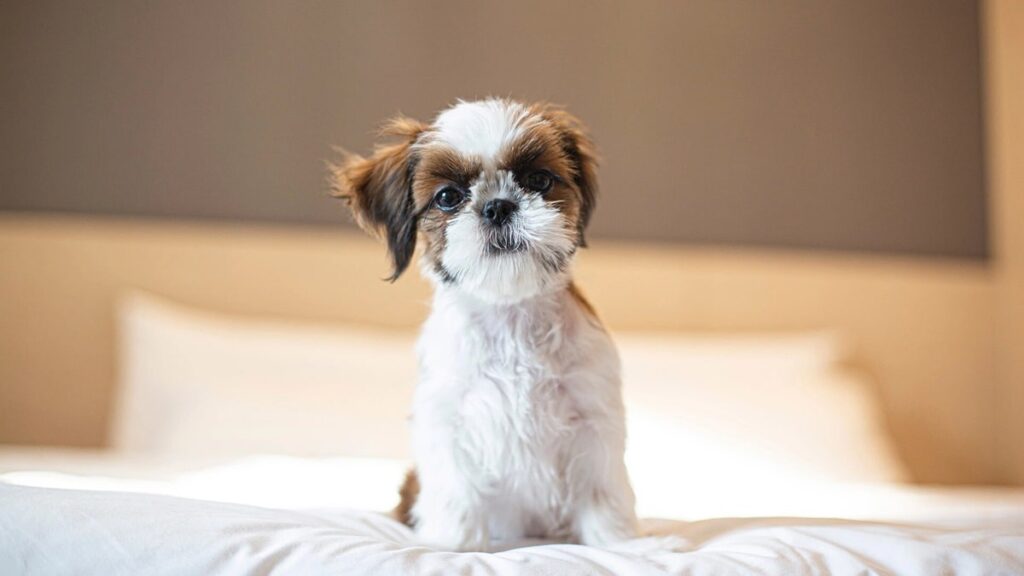Be patient, and everything will work out for you.
It is only necessary to train a dog to use a litter box when you don’t have the opportunity to take them for regular walks outside. Approach the task with patience, perseverance, and calmness, as it is advised.
Litter box rules.
We didn’t mention patience in vain: it will take time to toilet train a puppy. The optimal age for toilet training a pet is 4-5 months. The older the dog, the more challenging the training process becomes.
Start by getting a litter box with low sides. Choose newspaper or disposable pads to fill it. Before bringing the puppy home, remove carpets and rugs from the floor, as well as any other areas where the puppy may have accidents.
Observe the places the puppy chooses for its toilet needs. It does so based on instincts, which guide it on where to mark its territory. These places might be near doors, balconies, or windows. Place the litter box in those specific areas.
Initially, you can have multiple litter boxes available. Once the puppy chooses a favorite spot, leave only one litter box.
Cover the floor of the room with newspapers. After the puppy has identified its toilet area, gradually reduce the number of newspapers to a minimum. Initially, change the pads or paper less frequently: the scent will help the puppy orient itself and find its designated toilet area.
If the puppy chooses a cozy space like a bathroom, provide unrestricted access to it. If the puppy chooses locations that are not suitable for you, place food and water bowls there. Dogs generally avoid toileting where they eat.
Little tricks to quickly potty train a puppy.
Once you have prepared the litter box, start training your puppy.
- As soon as the puppy starts sniffing around and looking for a place to squat, guide them to the litter box.
- After meals and naps, also place the puppy in their litter box. Wait until they do their business.
- If the puppy used the litter box, praise them. Reward their behavior by giving them a treat and petting them.
- If the puppy has an accident on the floor, blot it with a cloth. Then place the cloth in the litter box and bring the puppy to that spot.
- If the puppy doesn’t find the designated toilet area and has an accident on the carpet or floor, let them know that it’s not allowed. Gently push their nose towards the mess and explain your rules in a firm voice. The stern tone will help the puppy understand their mistake.
Maintain patience and perseverance while following these guidelines.
Using a special spray can help train your puppy to use the designated area. Spray it on the puppy pad or newspaper. The spray will attract the puppy with its specific scent. On the other hand, there are other sprays that deter the puppy from certain areas.
Praise the puppy for every successful attempt to use the toilet. Soon, it will become a habit for them.
By the way.
Puppies usually go to the toilet after eating or engaging in active play. This moment can be caught if you carefully observe the puppy: they will start sniffing around, circling, or whining. If you pick up the puppy during these moments and take them to the litter box, they will quickly learn to go there. However, if the puppy stubbornly refuses to use the litter box and consistently chooses new spots or goes to the toilet too frequently, it may be worth showing them to a veterinarian or even a zoopsychologist.
Тема 2025: комфорт і турбота про улюбленців.
⚠️ We suggest that you read all the opinions on our portal and take note of them at your own discretion. Do not self-medicate! In our articles we collect the latest scientific data and opinions of authoritative experts in the field of health care. But remember: only a doctor can diagnose and treat.
The portal is intended for users over 13 years old. Some materials may not be suitable for children under the age of 16. We do not collect personal data from children under 13 without parental consent.We have a small request. We strive to create quality content about pet care, and we make it available for free to everyone because we believe everyone deserves accurate and useful information.
Advertising revenue only covers a small portion of our costs, and we want to continue to provide content without having to increase advertising. If you have found our content useful, please support us. It only takes a minute, but your support will help us reduce our reliance on advertising and create even more useful articles. Thank you!


